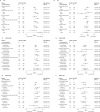Effects of prenatal small-quantity lipid-based nutrient supplements on pregnancy, birth, and infant outcomes: a systematic review and meta-analysis of individual participant data from randomized controlled trials in low- and middle-income countries
- PMID: 39154665
- PMCID: PMC11473441
- DOI: 10.1016/j.ajcnut.2024.08.008
Effects of prenatal small-quantity lipid-based nutrient supplements on pregnancy, birth, and infant outcomes: a systematic review and meta-analysis of individual participant data from randomized controlled trials in low- and middle-income countries
Abstract
Background: Undernutrition during pregnancy increases the risk of giving birth to a small vulnerable newborn. Small-quantity lipid-based nutrient supplements (SQ-LNSs) contain both macro- and micronutrients and can help prevent multiple nutritional deficiencies.
Objectives: We examined the effects of SQ-LNSs provided during pregnancy compared with 1) iron and folic acid or standard of care (IFA/SOC) or 2) multiple micronutrient supplements (MMSs) and identified characteristics that modified the estimates of effects of SQ-LNSs on birth outcomes.
Methods: We conducted a 2-stage meta-analysis of individual participant data from 4 randomized controlled trials of SQ-LNSs provided during pregnancy (n = 5273). We generated study-specific and subgroup estimates of SQ-LNS compared with IFA/SOC or MMS and pooled the estimates. In sensitivity analyses, we examined whether the results differed depending on methods for gestational age dating, birth anthropometry, or study design.
Results: SQ-LNSs (compared with IFA/SOC) increased birth weight [mean difference: +49 g; 95% confidence interval (CI): 26, 71 g] and all birth anthropometric z-scores (+0.10-0.13 standard deviation); they reduced risk of low birth weight by 11%, newborn stunting by 17%, newborn wasting by 11%, and small head size by 15%. Only 2 trials compared SQ-LNSs and MMSs; P values for birth outcomes were >0.10 except for head circumference (e.g., z-score for gestational age: +0.11; 95% CI: -0.01, 0.23). Effect estimates for SQ-LNSs compared with IFA/SOC were greater among female infants and, for certain outcomes, among mothers with body mass index <20 kg/m2, inflammation, malaria, or household food insecurity. Effect estimates for SQ-LNSs compared with MMSs were greater for certain outcomes among female infants, first-born infants, and mothers <25 y.
Conclusions: SQ-LNSs had positive impacts on multiple outcomes compared to IFA/SOC, but further research directly comparing SQ-LNSs and MMSs is needed. Targeting SQ-LNSs to vulnerable subgroups may be worth considering.
Clinical trial registry: This study was registered at PROSPERO as CRD42021283391.
Keywords: antenatal interventions; balanced energy protein supplementation; fetal growth restriction; infant stunting; infant wasting; low birth weight; maternal nutrition; preterm birth.
Copyright © 2024 The Author(s). Published by Elsevier Inc. All rights reserved.
Conflict of interest statement
Conflict of interest N.F.K. is on the Editorial Board of the American Journal of Clinical Nutrition and played no role in the Journal’s evaluation of the manuscript.
Figures






References
-
- Stevens G.A., Beal T., Mbuya M.N.N., Luo H., Neufeld L.M. Global Micronutrient Deficiencies Research Group, Micronutrient deficiencies among preschool-aged children and women of reproductive age worldwide: a pooled analysis of individual-level data from population-representative surveys. Lancet Glob. Health. 2022;10(11):e1590–e1599. doi: 10.1016/s2214-109x(22)00367-9. - DOI - PMC - PubMed
-
- [Internet] WHO Global Anaemia Estimates, 2021 Edition, World Health Organization, 2021 [cited 4 April, 2022]. Available from: https://www.who.int/data/gho/data/themes/topics/anaemia_in_women_and_chi....
-
- UNICEF Programming Guidance . UNICEF; New York: 2021. Maternal Nutrition: Prevention of malnutrition in women before and during pregnancy and while breastfeeding [Internet]https://www.unicef.org/media/114561/file/Maternal%20Nutrition%20Programm... [cited 18 March, 2024]. Available from:
-
- Women’s Nutrition [Internet]. United Nations Children’s Fund, 2023. https://data.unicef.org/topic/nutrition/womens-nutrition [cited 18 March, 2024]. Available from:

